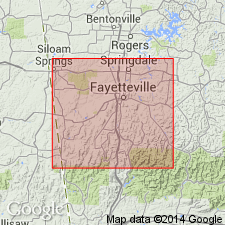
- Usage in publication:
-
- Eureka shale
- Modifications:
-
- Named
- Dominant lithology:
-
- Shale
- AAPG geologic province:
-
- Arkoma basin
Summary:
Eureka shale. A very black, argillaceous shale with a marked tendency to break up into prismatic blocks. Exposed in Washington County, Arkansas, in the Arkoma basin. Is well exposed at Mrs. Cook's Spring, near the center of sec. 32, T. 17 N., R. 31 W., where it consists of 12 to 15 feet of dark shale, with hard, gray and black layers. This shale is also seen at Ladd's Mill and at the ford of the Illinois River. Underlies the Boone chert and cherty limestone (new). In a footnote, J.C. Branner states the Eureka shale is the same as the "Black Shale" [Chattanooga] of Dr. Safford in Tennessee. Age is Devonian(?), possibly Early Carboniferous. Report includes geologic map of Washington County, stratigraphic table, columnar sections.
Type locality not specifically designated. Named from its occurrence in the valleys about Fayetteville, especially those of the West Fork of White River and its tributaries. [According to p. xiii, the formation was named by J.C. Branner; the description is by Simonds.]
Source: Modified from GNU records (USGS DDS-6; Denver GNULEX).
For more information, please contact Nancy Stamm, Geologic Names Committee Secretary.
Asterisk (*) indicates published by U.S. Geological Survey authors.
"No current usage" (†) implies that a name has been abandoned or has fallen into disuse. Former usage and, if known, replacement name given in parentheses ( ).
Slash (/) indicates name conflicts with nomenclatural guidelines (CSN, 1933; ACSN, 1961, 1970; NACSN, 1983, 2005, 2021). May be explained within brackets ([ ]).

